|
Back
Bach, Brahms, and Bruckner Montréal
Salle Wilfrid-Pelletier, Place des Arts
12/06/2010 - & December 7, 2010
Johann Sebastian Bach: Wachet auf, ruft uns die Stimme, BWV 645 (arrangement for piano by Ferruccio Busoni)
Johannes Brahms/Detlev Glanert: Vier Präludien und Ernste Gesänge (Four Preludes and Serious Songs)
Johann Sebastian Bach: Nun komm, der Heiden Heiland, BWV 659 (arrangement for piano by Ferruccio Busoni)
Anton Bruckner: Symphony No. 9 in D minor
Marie-Nicole Lemieux (Contralto), Jan Lisiecki (Piano)
Orchestre symphonique de Montréal, Kent Nagano (Conductor)

Kent Nagano (© Felix Broede)
On Monday night, the Orchestre symphonique de Montréal (OSM) presented an almost masterful performance of Bruckner’s Symphony No. 9 in D minor. In a close, literal reading, Conductor Kent Nagano and the OSM realized many dramatic, intimate and anguished moments.
Nagano maintained a tight rein on the mounting drama of the monumental first movement. The early brass climax almost overwhelmed. The horns and Wagner tubas, unusually seated behind the second violins at stage left, played flawlessly. (The basses, also in an unorthodox location, were positioned behind the first violins and the cellos at stage right.) All string sections performed with ardour and precision. Nagano conducted the entire movement with firm pacing and even balance among all components of the orchestra. He bridged the various themes gracefully and sustained the rhythm, permitting the audience to “float” along with the music.
The vigorous, colorful and imaginatively realized Scherzo could have used a little more sparkle.
The concluding Adagio unfolded with sweeping grandeur. Each thematic section excelled on its own, but Nagano had difficultly in maintaining a seamless dramatic line – so vital in connecting the conductor to the music and the music to the listener. The performance lacked warmth. It engaged, but didn’t really reach out and grab the listener. As one critic ventured, it felt a little “haughty”.
Before intermission, Marie-Nicole Lemieux, at the peak of her career, sang Brahms’s Vier Ernste Gesänge with color and imagination, accompanied by a purportedly “Brahmsian” orchestration by the German composer Detlev Glanert (b. 1960). Prior to, between, and after the Songs, Glanert contributed four connecting preludes and a postlude of his own composition. To me they recalled the music of Britten’s Peter Grimes or Elgar’s Sea Pictures. They did, however, provide a credible riff to the harmonic modernity of Bruckner’s Ninth.
Busoni transcriptions of two Bach chorale preludes, Nun komm, der Heiden Heiland (Now Come, Saviour of the Gentiles) and Wachet auf, ruft uns die Stimme (Sleepers, awake!) framed the Brahms Songs. Jan Lisiecki delivered a delicate, correct interpretation from a piano placed at the far side of the stage in front of the horns. This curious placement may have been intended to provide a transition from the horns, which played the final notes of Glanert’s Postlude, into the opening of Wachet auf. Nagano allowed only a few seconds pause between the two.
This concert formed part of the Montreal Bach Festival. Just two preludes, however, and transcriptions at that, totalling less than ten minutes, hardly qualify a concert to be part of a Bach festival.
Earl Arthur Love
|